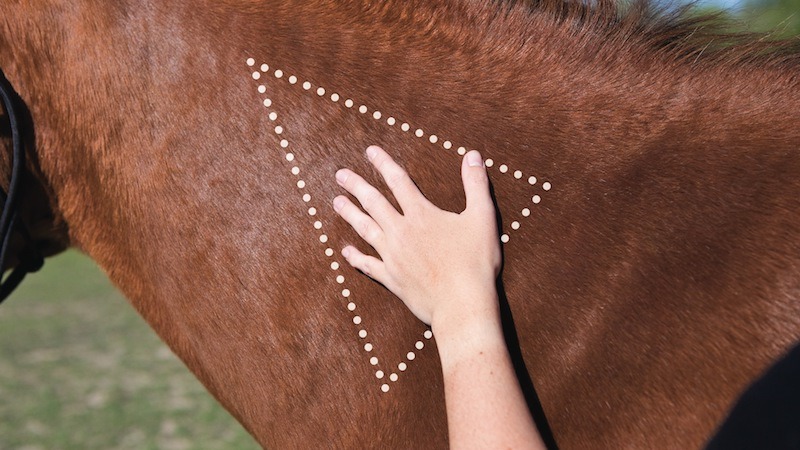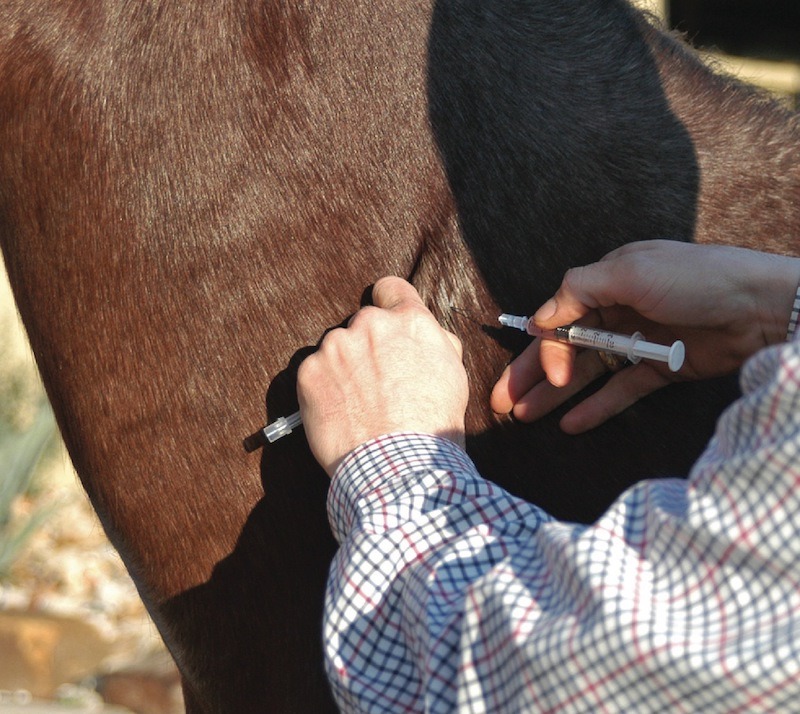There are right and wrong ways to give a horse a shot. It might be a mistake to assume you know what they are.
Veterinarian Stacey Tarr, DVM, of Wellington, Colorado, often teaches clients how to properly give their horses intramuscular injections, most often to administer antibiotics or vaccinations. It can be an asset to have a client able to give shots.
“If someone isn’t comfortable with doing it, that’s fine. It’s a personal preference,” he says. “I’m a realist. Sometimes it’s a money thing.”
It can help for a client to be able to keep a horse at home and give twice-daily penicillin shots, rather than housing the horse at the clinic or paying for farm calls for the veterinarian to do it. And some clients just like to give their own vaccinations.
However, Tarr wants his clients to do it right and be fully aware of potential problems.
Injecting the Neck
There are a number of large muscle groups in the horse that are good injection sites.
“It is one of those personal preferences, but I recommend the neck,” Tarr says. “I have some clients that would rather have horses vaccinated in the hip or buttocks. And with cattle, you give shots high up on the hip. In my opinion, you should avoid that with horses.
“If you give the shot up high on the hip and [the injection site] does abscess, there’s no place for that to drain but down into the abdomen, typically.”
He adds that in the case of a horse on long-term antibiotics, you might need to rotate injection sites daily. But for single injections like vaccinations, Tarr focuses on the neck.
“You look for the triangle of muscles in the neck,” Tarr explains. “It’s bordered dorsally [at the top] by the nuchal ligament. It runs along the top of the neck from the withers to the poll. It’s like a crane; it helps to lift their head up. The triangle is bordered ventrally [at the bottom] by the cervical, or neck, vertebrae. People think the vertebrae run up high in the neck, but they run lower.
“The back of the triangle is the front of the shoulder, where you run into the scapula.”

To find a central injection site, a good rule of thumb is to place your hand flat on the neck with the base of your hand against the horse’s shoulder. Aim for a spot on the neck near your thumb or the middle knuckles of your fingers.
“The whole area inside that triangle is muscle where you are safe to give an injection,” Tarr says. “It’s not like you have just a small spot to inject your needle.”
He says giving injections is a three-step process:
1. Clean the site. “I recommend using alcohol to clean the injection site,” Tarr says. “Just wipe the area with a swab of alcohol and let it set for 30 seconds.”
2. Use the right needle. “I like to use a 1½-inch needle because I want the vaccine or antibiotic to go in as far as I can get it. I don’t want to risk it lying only subcutaneously, under the skin,” he says.
3. Administer in one efficient action. “Gently pinch the skin up; inject the needle straight in, right where you pinched the skin, and continue to hold the skin; aspirate [draw back] on the syringe to make sure you don’t draw blood; give the injection; pull the needle straight out and let go of the skin,” Tarr explains.
Aspirating the syringe is important. When the needle is in the muscle, if you draw back on the syringe and pull blood into it, you know you’ve hit a vessel and should not proceed.
“If you do get blood, do not inject. You need to take the needle out and go to a different spot,” Tarr says. “It doesn’t have to be far; you can move to a spot one inch away.”
Blood in the syringe doesn’t harm the vaccine, he adds, and a new needle isn’t necessary.
Potential Problems
Tarr wants his clients to be able to recognize when a horse has a bad reaction to an injection, and know what to do about it. There are two reactions that are especially common with vaccinations: anaphylactic and injection-site reactions.
“The worst-case scenario is anaphylaxis,” Tarr says. “It’s rare. In 20 years, I’ve probably seen two [cases]. But it does happen.
“Anaphylaxis is a severe allergic reaction to some component in the injection or vaccine. It’s hard to tell exactly what, but it doesn’t really matter. It is life-threatening. The airways constrict, the heart rate goes up and the heart will often fibrillate. The horse needs to be treated by a veterinarian with epinephrine as quickly as possible.”
It happens fast, he says, within an hour at the most after injections are administered.
“It’s imperative that you get help,” he stresses. “Keep the horse as quiet as you can and get a veterinarian as quickly as possible. You don’t want to load it into a trailer; you need to get someone to it, fast.”
A horse can have that reaction with any kind of injection, Tarr explains. Often it’s not a reaction to the vaccine or medication itself, but another component in the injection.
“The horse was hypersensitized to something, and you don’t know why,” he says. “It happens to people, too. It’s what happens in people who are highly allergic to bees.”

Reactions at the injection site are much more common. The site might get hot to the touch and sore, and the horse’s neck might be sore for a couple of days, Tarr says.
“Treating your horse with anti-inflammatories like phenylbutazone or using a topical DMSO [dimethyl sulfoxide] will usually get it through,” he says.
Occasionally, he adds, this reaction can include tissue necrosis at the injection site that develops into an abscess. It will have to be opened, drained and flushed by your veterinarian, and the horse put on antibiotics.
One injection-site reaction usually means it will happen again, Tarr says, and it’s good to involve your vet at that point.
“In that case, I’ll pre-medicate the horse with Banamine [flunixin meglamine] the day I give a vaccine and the day after,” Tarr says. “That helps them get through a mild reaction. I track what vaccine I use every year, and I note a horse’s reaction in its record. If a horse is a chronic reactor [to a specific vaccination], I switch vaccines.”
A vaccine has an agent added to it called an adjuvant that boosts the particular immune response the vaccine initiates in the body. Tarr says the adjuvant can be the culprit behind an individual horse’s reaction. Since different pharmaceutical companies use different adjuvants, simply changing to a vaccine from a different manufacturer can help.
Other options might be to use an intranasal version of the vaccine if one is available. Or, it can be best to skip a particular vaccination. In the case of a 20-year-old gelding that chronically reacts to rhinopneumontis vaccination, Tarr says he might weigh the odds of the older horse contracting the disease against having an injection-site reaction, and simply recommend not giving it.
Regardless, Tarr always notes what vaccination the horse received and on which side of the neck.
“Anything with an “R”—like rhinopneumonitis or rabies—I give on the right side,” he says. “Anything else goes on the left side. If they react, and I’ve given two shots, I know which one they reacted to.”
Tarr recommends giving horses a break from hard work after they receive vaccinations.
“Their body is going to mount an immune response to the vaccine,” Tarr explains. “I want them to do that, and not be working, getting their heart rates up. Just give them the day off.”
However, the next day exercise can help a horse, especially if it is a little sore at the injection site.
“It’s like any sore muscle—moving around can help it,” he says
Article originally published in the June 2016 issue of Western Horseman.




1 Comment
Read the article on how to give my old mare a antibiotics shot as she has a bad cut on her right shoulder and no vet will come and help. Good article and I am going to use the advice. Wish this vet was in my area, budget and living out in the middle of nowhere doesn’t help but always need a good vet around.